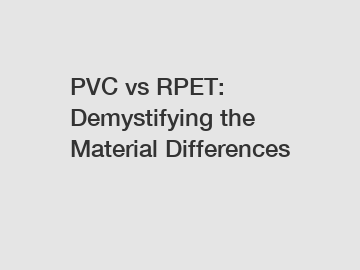PVC vs RPET: Demystifying the Material Differences
PVC vs RPET: Demystifying the Material Differences.
Polyvinyl Chloride (PVC) and Recycled Polyethylene Terephthalate (RPET) are two common materials used in various industries, but what sets them apart? In this article, I will provide a comprehensive explanation of the material differences between PVC and RPET, clarifying any confusion surrounding these materials. Understanding these differences is essential for making informed decisions about their usage in different applications.
PVC, a type of plastic, is derived from a combination of petroleum and salt. It is known for its durability, versatility, and affordability. On the other hand, RPET is a recycled plastic material that is derived from post-consumer PET products, such as water bottles. It is an environmentally friendly alternative to traditional plastics as it promotes recycling and reduces waste.

The differences between PVC and RPET lie in their manufacturing processes and properties. PVC is a thermoplastic polymer that can be easily molded into various shapes and forms, making it a preferred choice for applications requiring flexibility and durability. Its chemical composition includes chlorine atoms, which provide resistance to fire, chemicals, and weathering. This makes PVC an ideal material for construction, signage, and piping systems.
In contrast, RPET is a thermoplastic polyester that offers excellent transparency, strength, and recyclability. It undergoes a recycling process where PET bottles are collected, cleaned, and transformed into RPET flakes or pellets, which can then be used in the production of various products, including food packaging, apparel, and consumer goods. RPET's eco-friendly nature has made it increasingly popular, especially in industries focused on sustainability and reducing environmental impact.
The choice between PVC and RPET depends on several factors. For applications that require flexibility and durability, such as pipes or window profiles, PVC is the preferred choice. Its resistance to fire and chemicals makes it suitable for diverse environments. However, in applications where transparency and recyclability are key, such as food packaging, RPET is the more suitable option. The use of recycled materials in RPET reduces dependence on virgin plastics and contributes to a circular economy.
In recent years, there has been growing concern about the environmental impact of PVC due to its non-biodegradable nature and chlorine content. This has led to increased interest in RPET as a sustainable alternative. Many companies and industries are now actively adopting RPET as part of their sustainability initiatives, thus reducing their carbon footprint and promoting the use of recycled materials.
In conclusion, PVC and RPET are two distinct materials with unique properties and applications. PVC exhibits versatility and durability, while RPET offers transparency and recyclability. Both materials have different manufacturing processes and environmental impacts. By understanding these differences, industries can make informed decisions about which material to use based on their specific requirements. As sustainability and environmental consciousness continue to gain importance, RPET is poised to become an increasingly popular choice across various industries, contributing to a greener future.
The company is the world’s best rPET pellets, rPET pellets, rPET pellets supplier. We are your one-stop shop for all needs. Our staff are highly-specialized and will help you find the product you need.

Comments